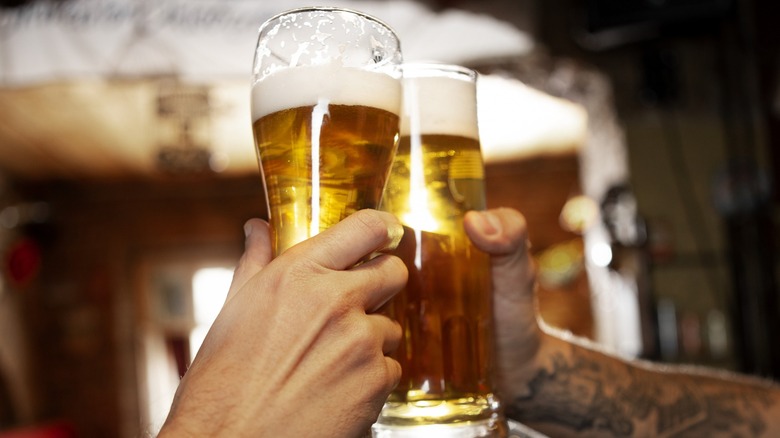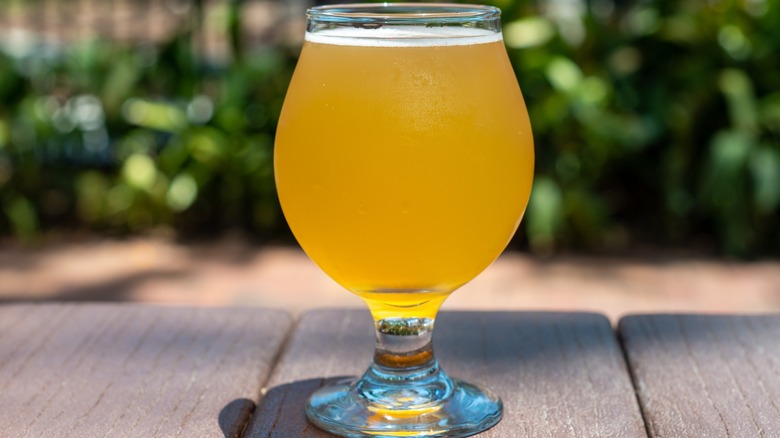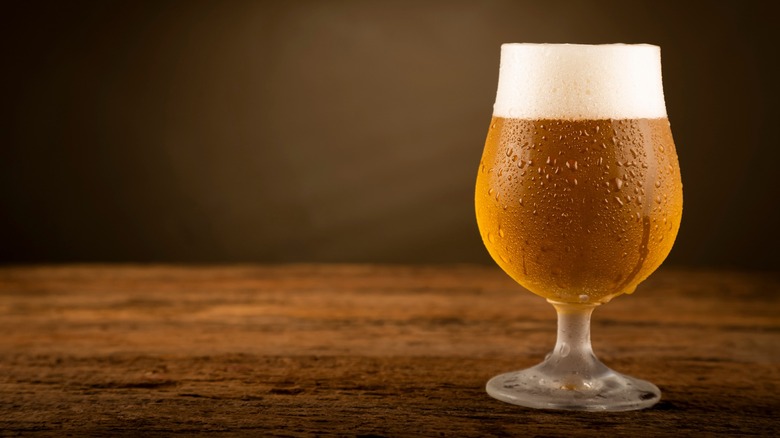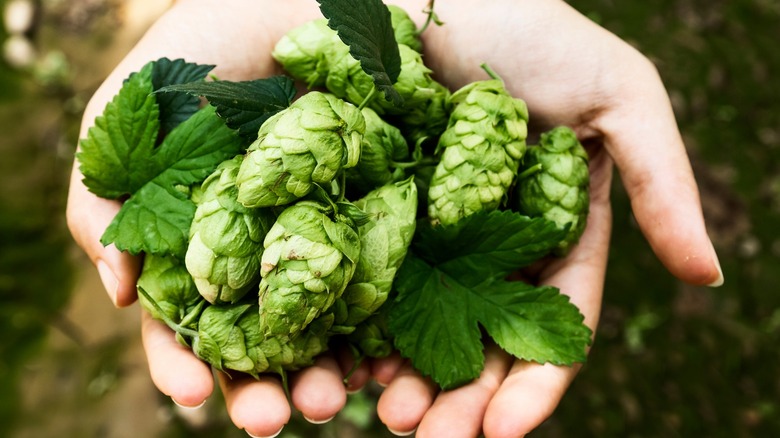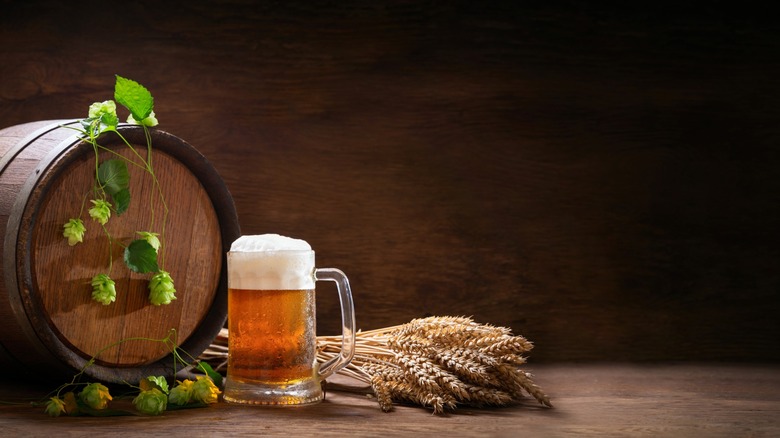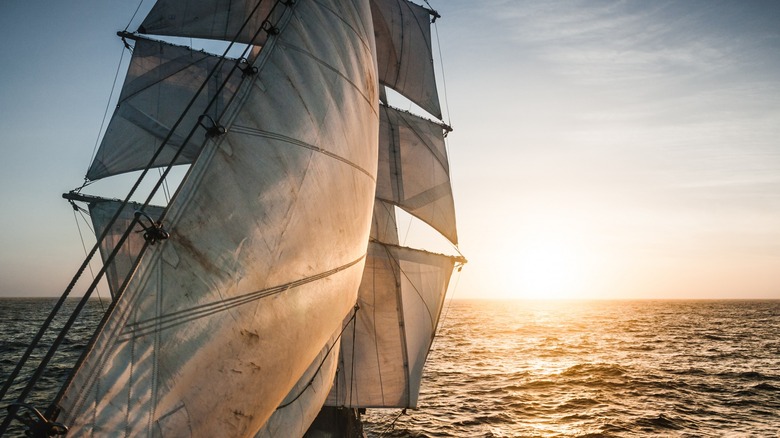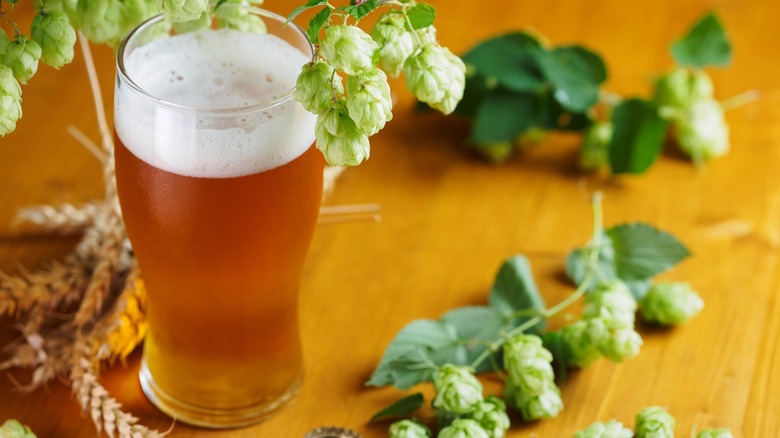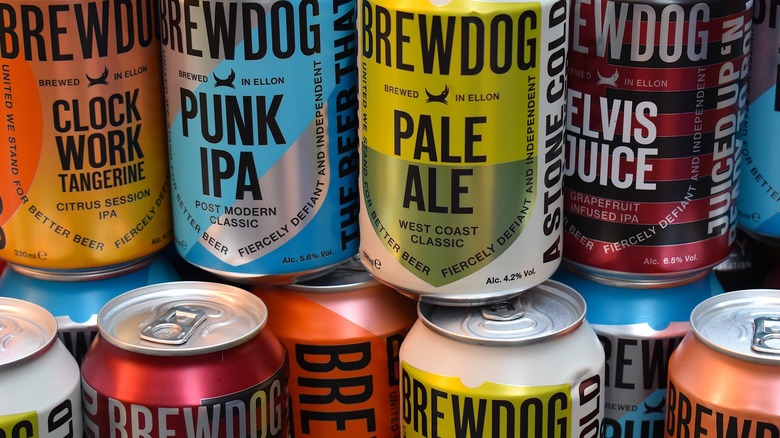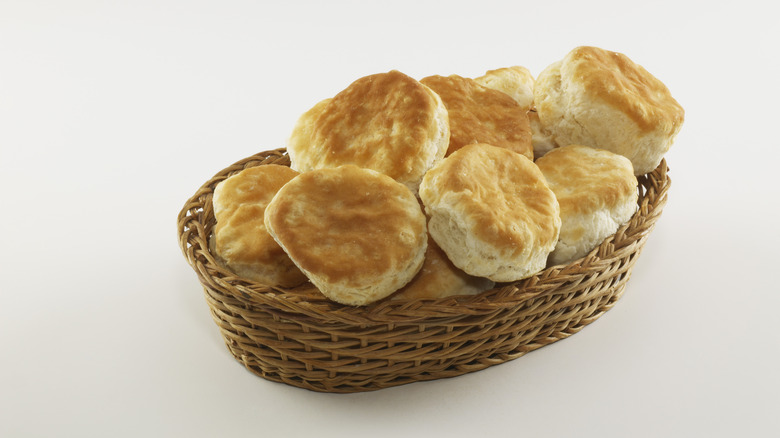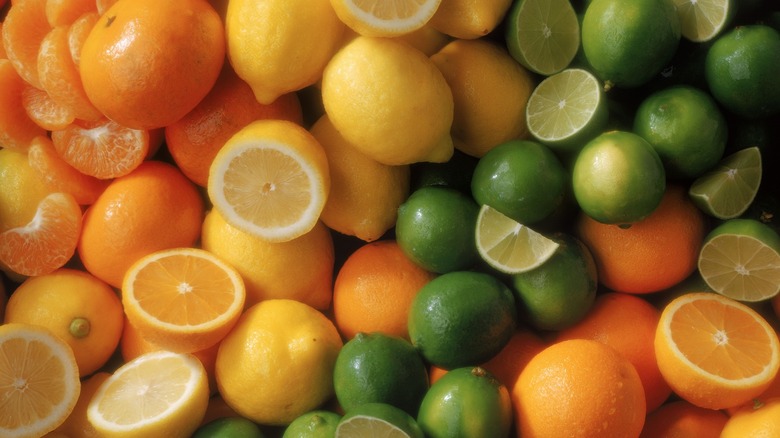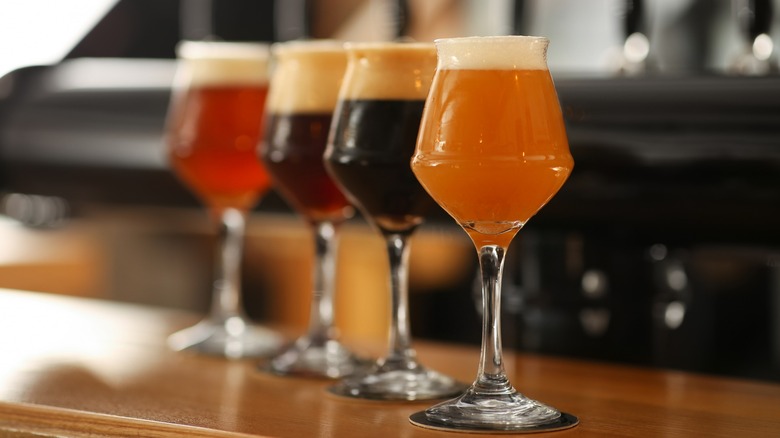Pale Ale Vs. IPA: Everything You Need To Know
Think you know everything there is to know about India pale ale (IPA) and pale ale? Or maybe you're new to craft beer and want to find out more about these two popular types of ale?
IPA, or India pale ale, is a type of pale ale, but the two have very different flavor profiles. Where pale ale has a light, biscuity flavor, IPA packs hoppier notes and, depending on the hop varietal used in brewing can also have herbal, citrus, or fruity notes.
We'll take a closer look at these two types of beer, including their origin stories and how they came to be. And, if you've always wondered how pale ale and IPA were different, we'll dive into some of the key differences between these two incredibly popular ales. So, pour yourself your beer of choice, sit back, and prepare to drink up some knowledge about pale ale and IPA.
What is pale ale?
Pale ale is a gold to amber color beer that's brewed with pale malt and ale yeast. This easy-to-drink beer does pack a certain amount of hoppy flavor, but it's malty, medium-bodied, and not nearly as bitter as IPAs.
There's more than just one type of pale ale. You'll find American pale ale, English pale ale, and blonde Ale — and that's just naming a few. Pale ale also generally has a lower alcohol content than most IPAs.
Pale ale originated in England, with the term being used to describe any English ale that was lighter than the ever-popular Porter. Until the late 1700s, most English beers were dark in color, and it wasn't until the start of the 1800s that pale ales began to become popular. At the time, they ranged in color from pale yellow to copper or amber, and the term "pale ale" included beer styles such as IPA, English bitter, and amber ale.
What is IPA?
IPA stands for India pale ale, and, as the name suggests, is actually a type of pale ale. Unlike the biscuity notes of pale ale, however, IPA can have citrus, herbal, or even fruity notes, depending on the variety of hops used. Speaking of hops, IPA is usually much hoppier than most pale ales, too.
Most IPAs have a bitter flavor profile, with a higher ABV than pale ale. There are many different types of IPA, including New England IPA, West Coast IPA, and even Black IPA.
Though we'll go into more detail on the history of IPA later, it should be noted here that IPAs quickly became a popular alternative to the more commonplace darker beers of the time. And, its roots can be traced to the 1780s when the East India Company realized Porter deteriorated in quality on the six-month journey from Britain to India.
IPA is hoppier than pale ale
IPA isn't a hit with every beer drinker, and that's largely because of its hoppy flavor. More hops are used during the brewing process when making IPA, which is why some types of IPA can taste quite bitter — great, if that's your thing.
Often, those new to craft beer try IPAs first. However, the amount of bitterness in your beer will depend on which variety you choose.
While the hoppy flavor is predominant amongst most IPA varieties, you'll find that New England IPAs are easier to drink as they're usually less bitter than some other varieties and pack a fruity punch. West Coast IPAs sit nicely in the middle, with some bitterness and some fruitiness, but not an overwhelming amount of either.
The hoppy or bitter flavor of IPA depends on the variety of hops used. If you're not a fan of one type of IPA, it makes sense to try different types to see if you can find one that's to your liking.
Pale ale has been around longer than IPA
Pale ale in general has been around longer than IPA and very likely existed in some form or another in the mid to late 1600s, as roasting hops began to be done with coke (the near-smokeless version of coal). Before that hops were roasted over wood or pete fires, causing the malts to become brown and take on a smoky flavor.
But, the lighter beer available at the time wouldn't have been the yellow and golden hues we are used to today. Instead, the pale ale of the time would have been a deep red color more akin to the amber ale we enjoy today.
However, pale ale really had its heyday from 1790 onwards, when a cunning brewer decided to add extra hops to beer in order to solve a problem for the East India Company. The goal? To create a beer that was able to withstand the long journey by sea from England to India.
IPA was designed to survive the journey from Britain to India
The East India Company in the U.K. was once the main company responsible for trade with India. In the late 1700s, traveling by ship from the U.K. to India took around six months. However, Porter, the most popular beer of the time, didn't travel well on the long journey across the seas.
At the time, the main supplier of Porter to the East India Company was George Hodgson's Bow Brewery of London. The brewery tried almost everything it could think of in order to ensure the Porter arrived in India in drinkable condition, to no avail.
In the late 1700s, Hodgson decided to ship Barleywine, known at the time as "October Beer," as an alternative to Porter. Because the beer was brewed with extra hops and continued to age during the journey, it actually became tastier during the six-month voyage. This strong, pale, bitter beer became India's first pale ale, later evolving to be called IPA.
IPAs are more bitter
One thing that puts many people off IPAs — but is also the reason they're so popular with others — is their distinctive bitter taste, which comes from the extra hops added to the pale ale. Whereas pale ales can be malty, biscuity, and easy to drink, IPAs don't go down quite as easily.
The extra hops in IPA often give the drink notes of pine, resin, citrus, or herbs, depending on the type of hops used. And, there are many different styles of IPA, as we mentioned earlier, each with its own flavor profile.
If you're not a fan of the bitterness, opt for hazy IPAs, which tend to have a fuller flavor but are generally less bitter than some other types of IPA. Incidentally, New England IPA is often a great beer to try if you're new to IPAs. You could even try Belgian IPA, which packs some of the sweetness found in Belgian tripel beers. Or go for a milkshake IPA, which has low carbonation and milk sugar, great for fans of a smooth stout.
Pale ale usually has a lower ABV than IPA
Another of the main differences between these two beers is the alcohol content or ABV. You'll generally find that most IPAs are stronger than pale ales. IPA is usually around 5% to 7.5% ABV, whereas the average pale ale ABV is around 4% to 6.5%.
There are exceptions, though. Session IPAs are lower in alcohol content and designed for "session" drinking, where you have more than a couple of beers. Session IPAs are typically around 3% to 5% ABV.
On the other end of the scale, imperial IPAs are also known as double IPAs, and usually have an ABV of at least 8%; however, they can range in ABV from 7.5% to around 10%. These IPAs also pack more bitterness than some other varieties and are often darker in color. The ABV can also vary depending on the style of IPA you're drinking, for example hazy, juicy, West Coast, English, or American.
Pale ale has biscuity notes
We already mentioned that pale ale is often easier to drink than IPA. This medium-bodied ale ranges in color from a light straw yellow to a deep amber. Most pale ales contain biscuity, and malty notes in contrast to the bitterness of IPA.
Most British pale ales range from a copper color to a deep golden brown, with a hint of bitter hops contrasting beautifully with the sweet malty biscuit flavors. On the nose, you'll detect woody, earthy, spicy notes — and sometimes even a hint of marmalade.
Then there's English-style bitter, which, despite its name, has citrus and fruity flavors, with less malt sweetness at the back end of the flavor profile. American pale ale has a more fruity, floral flavor than its British counterpart. Blonde or golden ales boast a well-rounded flavor that makes for easy drinking and are an excellent beer to accompany most foods, especially Italian pasta dishes and salads.
IPA can pack fruity, herbal, or citrus notes
We already mentioned that IPAs are generally hoppier than pale ales, but they can also pack citrus, herbal, pine, or fruity notes. The notes in this style of beer largely depend on the variety of hops used. If you enjoy the piney notes in some IPAs, look for those brewed with Chinook or Simcoe hops, the two varieties most likely to impart pine flavors into the beer. Centennial or Cascade hops often leave a zingy grapefruit note, while beer brewed with Amarillo or Galaxy hops is often less bitter than some others.
You'll find some IPAs are known for their bitter flavor, such as Imperials, while milder varieties like West Coast IPA blend bitterness with fruity flavors which often derived from hops like Citra and Mosaic known for their citrus and berry notes, respectively. For even fresher, fruitier notes, without the bitterness, New England IPAs or hazy IPAs should be your go-to.
You can get a dark IPA
Though IPA stands for India pale ale, not all IPAs are light in color. Confused yet? You can actually get a dark IPA, known as black IPA, Cascadian dark ale, or American-style black ale. These IPAs are brewed with darker malts, so appearance-wise they look pretty similar to porter and stout.
Don't be fooled though — there's none of the sweetness or low carbonation of a milk stout here, though there's a lot of roasted malt going on. Black IPAs are intense and hoppy, often with notes of caramel or chocolate. They usually also have a high ABV of between 5% to 10%.
For those new to IPAs who are fans of stout and porter, the color of a black IPA might be instantly appealing. However, the flavor profile is totally different from other dark beers, though they do share the same roasted malt notes.
